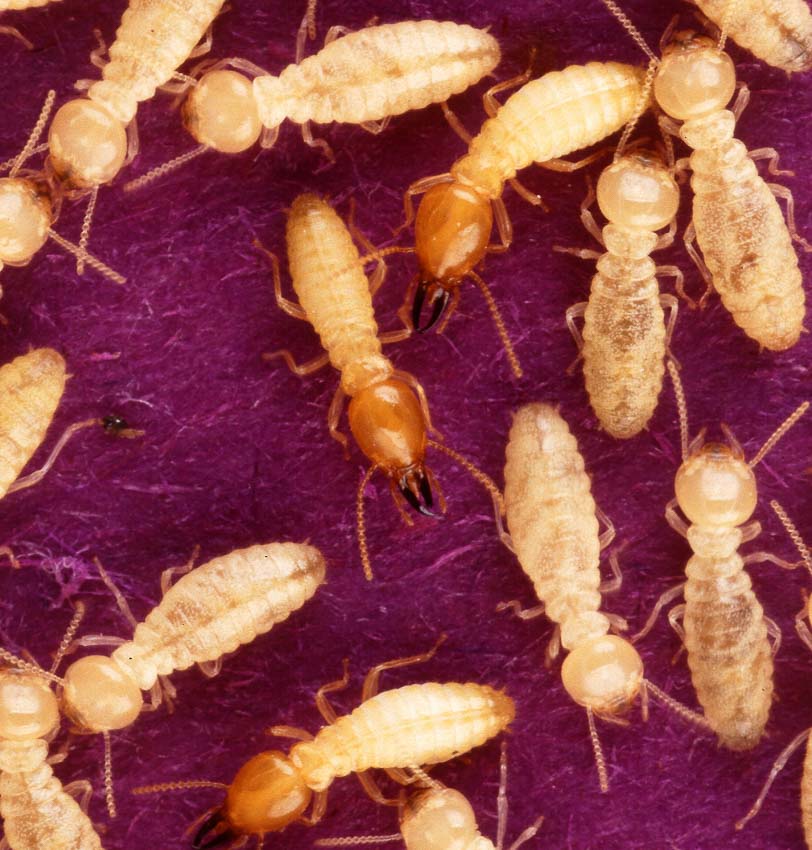Termites live in large colonies with up to a million individuals. They often make their nests inside people’s houses, causing billions of dollars in damage yearly. Learn how to identify and get rid of termites to protect your home and preserve the value of your property.
Getting to Know Termites
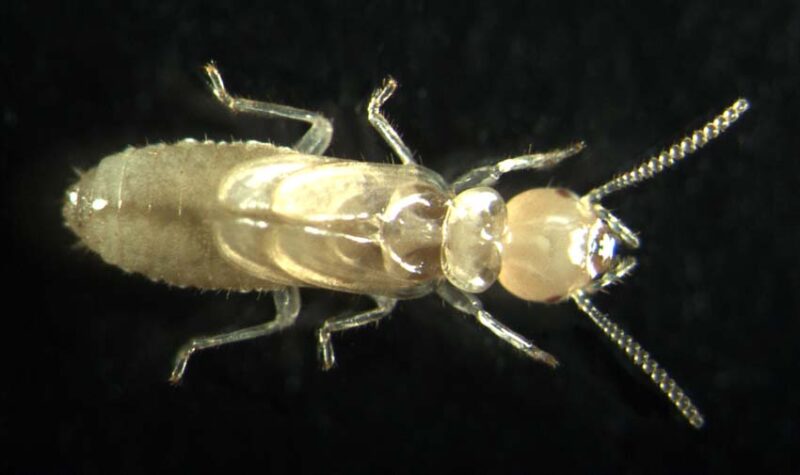
When you’re fighting against termites, you’re fighting against hundreds of thousands of individual termites, all working together for a common purpose.
Termites are insects with complex social structures, like bees and ants. Individuals communicate and cooperate with each other for the benefit of the colony, using a caste system to ensure the success of their species.
The Biology of Termites
Termites are small insects about ¼ to ½ inch in length. They are often confused with carpenter ants, and while they have many similar characteristics, they are not closely related.
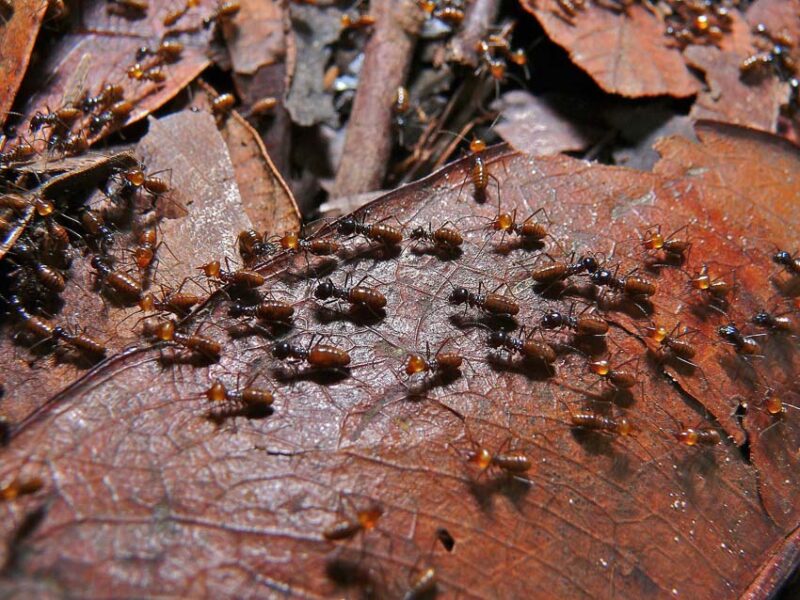
Like ants, termites use caste systems, where individual termites are assigned specific duties. Termites are also similar to ants in that they are attracted to decaying organic matter, such as wood and leaves.
The Caste System
The members of each caste have distinct appearances, which can confuse the identification of termite species. There are three main castes of termites: workers, soldiers, and reproductive.
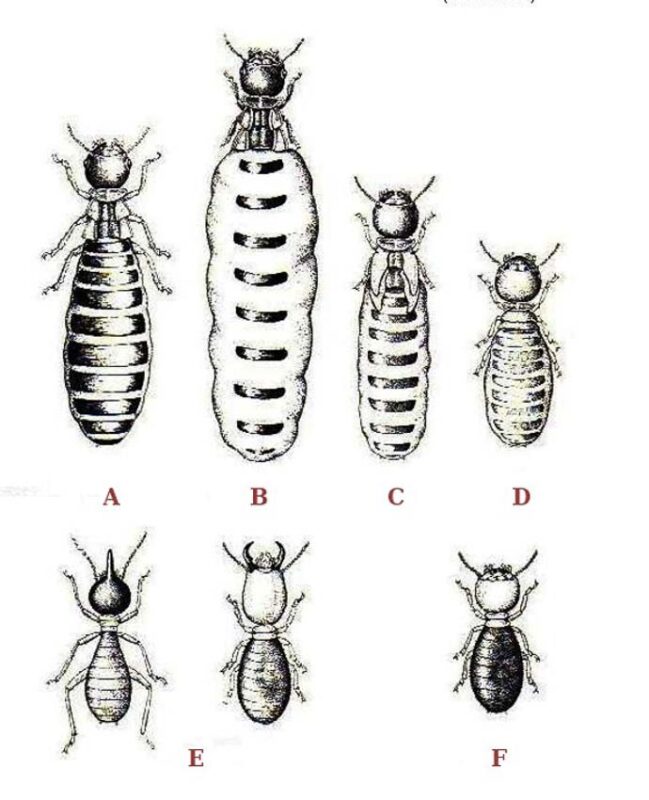
B. Queen
C. Secondary queen
D. Tertiary queen
E. Soldiers
F. Worker
Termites are eusocial creatures. Eusociality is considered the highest form of an organized society, and it only occurs in a few species. To be considered eusocial, a species must display certain characteristics:
- Cooperative brood care–they raise their offspring together.
- Division of labor–they use a caste system to divide labor and responsibilities
- Overlapping generations–there are adult members from at least two overlapping generations
After a termite egg hatches, the termite develops into a reproductive or non-reproductive caste member. In termites, the workers and soldiers can be male or female, but they do not reproduce.
King and Queen Termites
The reproductive members of a termite colony are known as the king and queen. The king and queen termites are larger than workers and soldiers. The king is usually about an inch long, and queen termites can grow as large as 4 to 6 inches.
King and queen termites also live longer than worker and soldier termites. In some species, termite kings can live up to a decade, and queens can live more than 20 years.
Termite Life Cycle: An Insight
Like almost all insects, termites produce eggs. The king and queen live in the center of the nest, and she lays about one egg every three seconds, about 30,000 eggs per day, and over 11 million eggs per year.
This, in part, makes termites hard to get rid of.
Termites have an incomplete metamorphosis life cycle, meaning three distinct stages exist. Once a termite egg hatches, it becomes a tiny nymph. The nymphs molt several times before becoming adults, a process that takes about one year in termites.
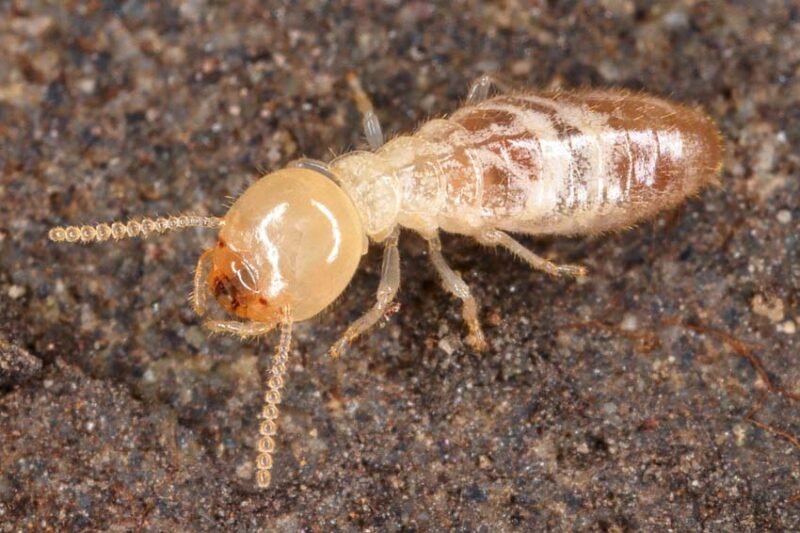
During the nymph stage, termites can metamorphose into supplementary reproductive members.
During certain times of the year, the supplementary reproductive termites will find mates. Once a new king and queen meet, they find a new home, shed their wings, and start a new colony.
How to Identify Termites
The termites you see wandering around your house and property are probably worker termites whose job is to forage for food. Worker termites represent the largest group of individuals in a colony, but they are smaller than the other caste members, and different species of worker termites tend to look similar.
Physical Characteristics of Termites
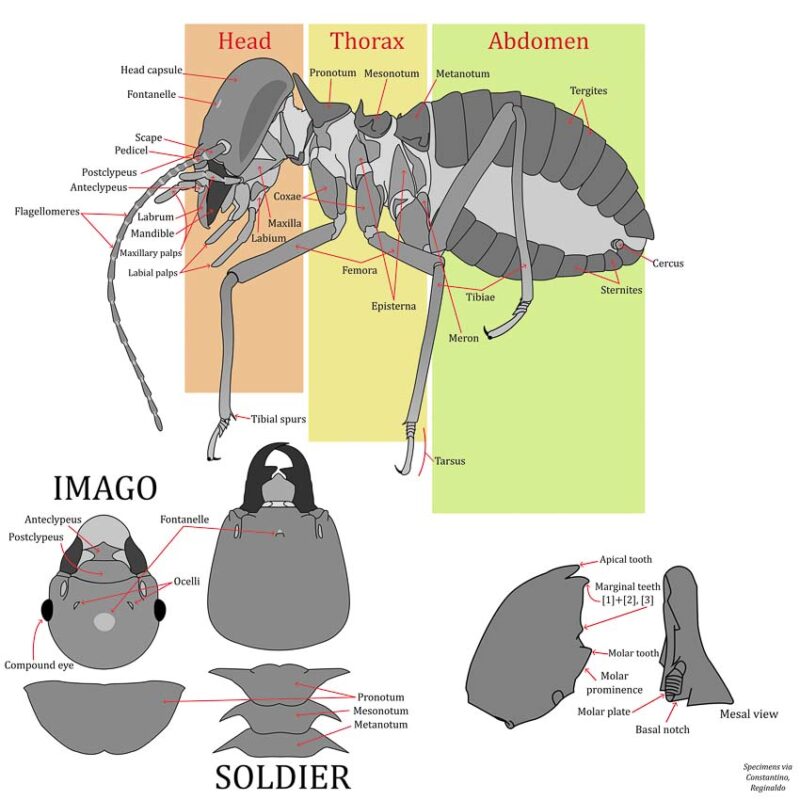
There are almost 3,000 different species of termites. While termites are often confused with ants, they have wide, straight bodies, and if you look closely, they are easy to distinguish from ants.
Colors
Termites are usually off-white or tan, but they can range in color from red or brown to black. Different caste members in certain species are also different colors.
Eyes
Except for the king and queen, termites do not have eyes. They are blind, and they rely on antennae and olfactory receptors to sense their world.
Antennae
Worker termites have straight antennae. Since ants have curved antennae, it’s easy to tell the difference between them just by looking at their antennae. Soldier termites also have pincers.
Wings
Termites have two pairs of wings, which are the same length and mounted just below the head. Only reproductive caste members are winged. Termites with wings are known as swarmers or alates.
If you see winged termites, they are probably looking for a new home.
Identifying Termites
Before you can get rid of termites, you have to know how to identify them. Identifying termites and distinguishing them from other types of insects is easier than classifying them as a specific type of termite.
If you’re trying to classify a specific type of termite, it helps to have a soldier or alate. Most winged termite swarmers fly around in the spring and summer, but some types are more likely to swarm in the fall.
Common Types of Termites You Might Encounter
All termites are attracted to organic matter that contains cellulose, such as wood, dry leaves, and paper. Although there are thousands of termite species, the three main types you will encounter are subterranean, drywood, and dampwood termites.
Subterranean Termites
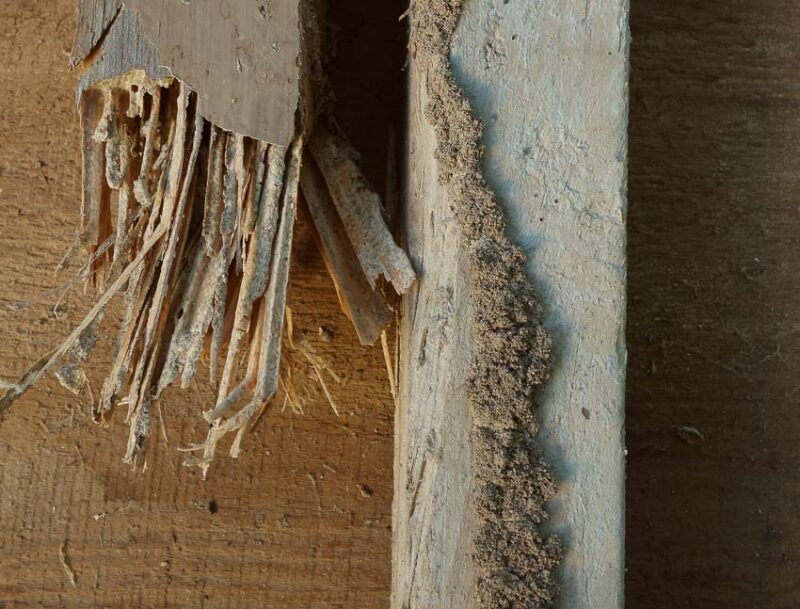
Subterranean termites build their nests underground. These are the most destructive and widespread types of termites in the United States.
They form large underground colonies, and their nests have mud tubes that connect them to their food source.
Drywood Termites
This type of termite doesn’t need direct contact with the soil, and they will build nests in trees, wooden walls, hardwood floors, and roof timbers. Even though they are called drywood termites, they sometimes build their nests near water sources such as leaky pipes.
They form smaller colonies than subterranean termites and cause less damage. Drywood termites usually swarm in the fall.
Dampwood Termites
As their name suggests, dampwood termites prefer wood with high moisture content. They do not require contact with the soil like subterranean termites, but they are not usually found in buildings because there is not enough moisture in the timbers of manmade structures.
Signs of a Termite Infestation
If you suspect that you have a termite infestation, call a professional exterminator right away. Most companies offer a free inspection that will set your mind at ease.
Visible Damage Caused by Termites
Termite damage can be hard to identify, but you may notice buckling floorboards, peeling paint, drooping drywall, and loose tiles. Doors and windows that are suddenly hard to open or shut can indicate structural damage caused by termites.
Subtle signs: What to watch out for
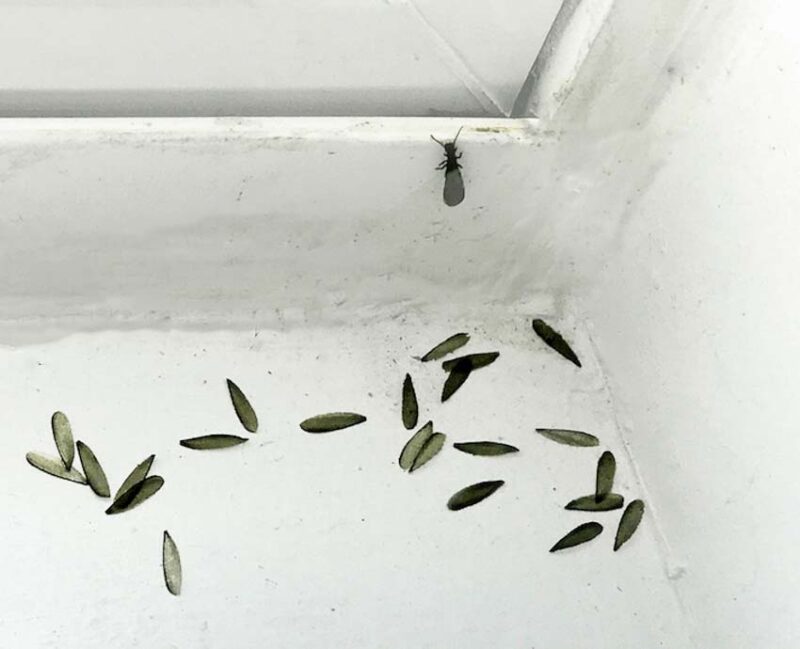
Visible damage caused by termites is usually preceded by the damage you can’t see, eventually leading to structural problems. Keep your eye out for tiny holes in drywall and wood that sounds hollow.
You should also look for signs of termite activity, including live and dead insect bodies, shed wings, and mud tubes. Anytime you see termite swarmers in and around your home, whether alive or dead, it’s time to look for more clues.

How to Get Rid of Termites: Effective Strategies
By making a concerted effort, there are effective strategies for getting rid of termites. Learn more about DIY termite control methods, professional termite removal services, and the efficacy of chemical treatments.
DIY termite control methods
Treating a termite infestation yourself isn’t recommended by many people, but if you catch it early, you might be able to treat it successfully. Here are the best home remedies to use:
- Use termiticides around the foundation of your home.
- Use termite baits and traps.
- Treat your yard with beneficial nematodes .
- Place diatomaceous earth around your foundation, attic, and anywhere you have seen a termite alate.
- Use neem oil or homemade essential oil sprays made with peppermint, thyme, citrus, or rosemary oil to get rid of termites naturally.
- Spray boric acid in areas that are infested with termites. Reapply weekly until they are gone.
Use preventative measures if you live in an area where termite infestations are likely. Remove piles of wood and debris on your property, and monitor your house regularly to ensure you don’t have any signs of termites.
Professional termite removal services
Professional termite extermination typically costs between $400 and $900, depending on the size of your house. Termites cause significant damage to buildings, and most insurance companies won’t cover the cost of damage or removal.
To avoid out-of-pocket expenses, it’s usually best to call a professional for a free inspection if you think you have an infestation. It’s also prudent to schedule regular termite inspections, especially if your home has previously been treated for termites.
Professionals have more potent chemicals available to them, and they also understand how to apply them so you don’t harm other species. When hiring a professional service, research them by reading online reviews and asking them for references.
Ask them for their credentials to ensure they are licensed and certified, and find out if they offer warranties on their work.
Chemical treatments and their efficacy
Spraying for termites is usually an effective way to get rid of them, but you should know that termiticides can contaminate well water and children’s play areas, so it’s best to use caution. Since termites reproduce so quickly, if you don’t kill the king and queen, or if new ones are established, the termites will repopulate within a few months.
Preventing Future Termite Infestations
Whether or not you’ve had a termite infestation at your home, preventing a future one is the best course of action. So that you never have to get rid of termites, here are the best practices for prevention inside your home and outdoors in your yard:
Best Practices for Termite Prevention in Your Home
Conduct regular home inspections to ensure you have no termite problems. Check likely places, such as your attic, basement, crawl spaces, and garages, and repair leaky pipes to avoid attracting termites.
Look for termite damage in other common areas, like the structural beams in your house, including the timbers that support your roof. Always be on the lookout for mud tubes that termites use to move around without being seen.
Landscaping Tips to Deter Termite Infestations
Termites are attracted to anything that contains cellulose, especially wood, paper, and dry leaves. Keep your yard tidy and follow basic yard care routines to ensure no debris will attract termites.
Keep gutters clean and clean up leaves in the fall.
Avoid using wood landscaping mulch in your flower beds, which attracts termites and other insects, especially around your home’s foundation. A good alternative is rubber mulch, which has the additional benefit of keeping its color and staying where you put it.
Frequently Asked Questions on How to Get Rid of Termites
How fast can termites cause significant damage?
It can take 3 to 8 years for a termite colony to become established and create visible signs of damage. By then, the damage is already severe and will likely cost you thousands of dollars.
Can you get rid of termites without professional help?
Termites cannot be eliminated entirely, but you can get rid of them from your home without professional help if you are dealing with a small colony. For large infestations, call a professional immediately instead of waiting while they cause more damage.
Are certain types of wood more prone to termite infestation?
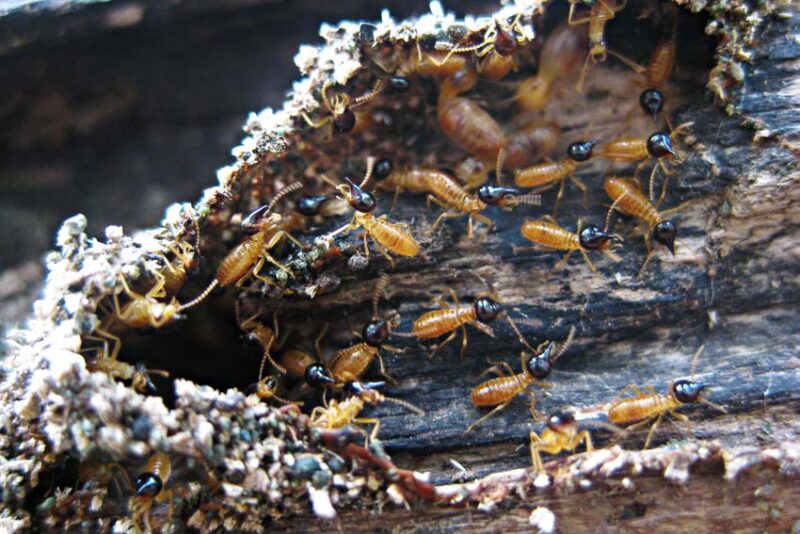
Termites chew through all types of wood, but they prefer softwoods like pine, cedar, and fir instead of hardwoods or treated lumber.
How often should I inspect my property for termites?
If you live in one of the worst states for termite damage, such as Florida, Georgia, California, and Texas, you should have your home inspected at least once a year. If you’ve had a previous infestation, have it inspected by a professional at least twice a year.
What should I do if my neighbor has a termite infestation?
Termites don’t recognize property lines, so if your neighbor has a termite infestation, they will likely move to your house in due time. Call for an inspection and extermination as soon as possible.
Got problems in the garden? Read our guide on how to get rid of slugs!

